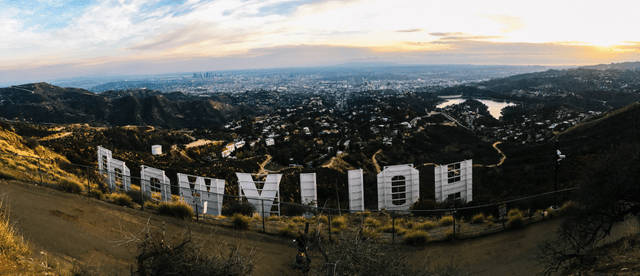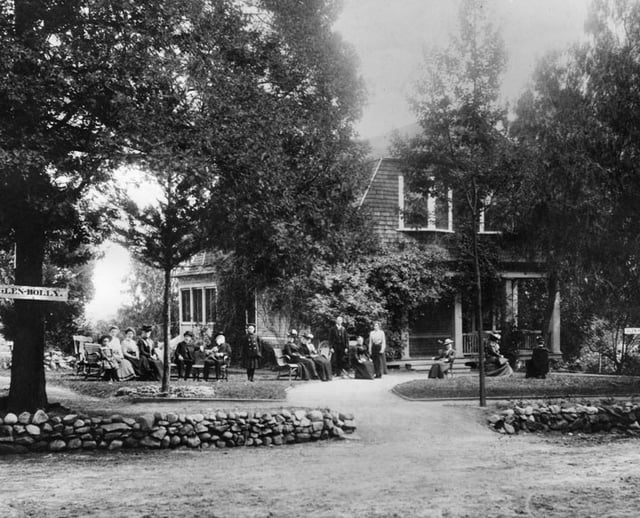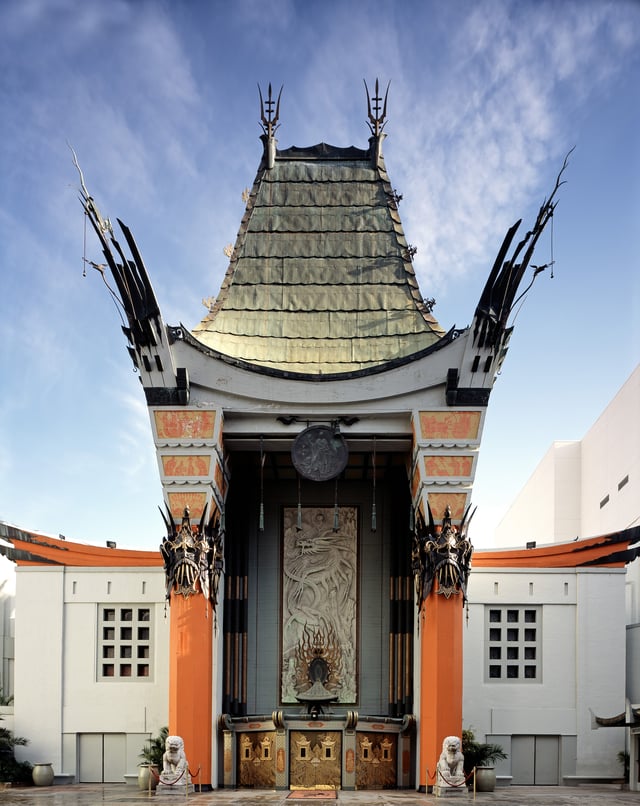Hollywood

Hollywood
Hollywood is a neighborhood in the central region of Los Angeles, California, notable as the home of the U.S. film industry, including several of its historic studios. Its name has come to be a shorthand reference for the industry and the people associated with it.
Hollywood was incorporated as a municipality in 1903.[2][3] It was consolidated with the city of Los Angeles in 1910 and soon thereafter, a prominent film industry emerged, eventually becoming the most recognizable film industry in the world.[4][5]
| Coordinates: | |
| Country | United States |
|---|---|
| State | California |
| Elevation | 108 m (354 ft) |
| Area code | 323 |
History
Early history and development

Original 480 acre map of H. J. Whitley property developed by his company, Los Angeles Pacific Boulevard and Development Company. Highland Avenue runs through the center of the property. The square at the lower right hand corner is the Whitley Estate and was not part of the Grand View development.

Glen-Holly Hotel, first hotel in Hollywood, at the corner of what is now called Yucca Street. It was built in the 1890s.

The intersection of Hollywood and Highland, 1907

Newspaper advertisement for Hollywood land sales, 1908

HJ Whitley is the man standing on the left wearing a bowler hat.
In 1853, one adobe hut stood in Nopalera (Nopal field), named for the Mexican Nopal cactus indigenous to the area. By 1870, an agricultural community flourished. The area was known as the Cahuenga Valley, after the pass in the Santa Monica Mountains immediately to the north.
According to the diary of H. J. Whitley, also known as the "Father of Hollywood", on his honeymoon in 1886 he stood at the top of the hill looking out over the valley. Along came a Chinese man in a wagon carrying wood. The man got out of the wagon and bowed. The Chinese man was asked what he was doing and replied, "I holly-wood," meaning 'hauling wood.' H. J. Whitley had an epiphany and decided to name his new town Hollywood.[6] "Holly" would represent England and "wood" would represent his Scottish heritage. Whitley had already started over 100 towns across the western United States.[7][8]
Whitley arranged to buy the 480-acre (190 ha) E.C.
Hurd ranch.
They agreed on a price and shook hands on the deal.
Whitley shared his plans for the new town with General Harrison Gray Otis, publisher of the Los Angeles Times
Daeida Wilcox learned of the name Hollywood from Ivar Weid, her neighbor in Holly Canyon (now Lake Hollywood) and a prominent investor and friend of Whitley's.[9][10] She recommended the same name to her husband, Harvey. H. Wilcox, who had purchased 120 acres on February 1, 1887. It wasn't until August 1887 Wilcox decided to use that name and filed with the Los Angeles County Recorder's office on a deed and parcel map of the property. The early real-estate boom busted at the end of that year.
By 1900, the region had a post office, newspaper, hotel, and two markets.
Los Angeles, with a population of 102,479 lay 10 miles (16 km) east through the vineyards, barley fields, and citrus groves. A single-track streetcar line ran down the middle of Prospect Avenue from it, but service was infrequent and the trip took two hours. The old citrus fruit-packing house was converted into a livery stable, improving transportation for the inhabitants of Hollywood.
The Hollywood Hotel was opened in 1902 by H. J. Whitley, who was a president of the Los Pacific Boulevard and Development Company. Having finally acquired the Hurd ranch and subdivided it, Whitley built the hotel to attract land buyers. Flanking the west side of Highland Avenue, the structure fronted on Prospect Avenue, which, still a dusty, unpaved road, was regularly graded and graveled. The hotel was to become internationally known and was the center of the civic and social life and home of the stars for many years.[11]
Whitley's company developed and sold one of the early residential areas, the Ocean View Tract.[12] Whitley did much to promote the area.
He paid thousands of dollars for electric lighting, including bringing electricity and building a bank, as well as a road into the Cahuenga Pass. The lighting ran for several blocks down Prospect Avenue. Whitley's land was centered on Highland Avenue.[13][14] His 1918 development, Whitley Heights, was named for him.
Incorporation and merger
Hollywood was incorporated as a municipality on November 14, 1903, by a vote of 88 for and 77 against. On January 30, 1904, the voters in Hollywood decided, by a vote of 113 to 96, for the banishment of liquor in the city, except when it was being sold for medicinal purposes. Neither hotels nor restaurants were allowed to serve wine or liquor before or after meals.[15]
In 1910, the city voted for merger with Los Angeles in order to secure an adequate water supply and to gain access to the L.A. sewer system.
With annexation, the name of Prospect Avenue changed to Hollywood Boulevard and all the street numbers were also changed.[16]
Motion picture industry

Nestor Studio, Hollywood's first movie studio, 1912

Hollywood movie studios, 1922
By 1912, major motion-picture companies had set up production near or in Los Angeles.[17] In the early 1900s, most motion picture patents were held by Thomas Edison's Motion Picture Patents Company in New Jersey, and filmmakers were often sued to stop their productions. To escape this, filmmakers began moving out west to Los Angeles, where attempts to enforce Edison's patents were easier to evade.[18] Also, the weather was ideal and there was quick access to various settings. Los Angeles became the capital of the film industry in the United States.[19] The mountains, plains and low land prices made Hollywood a good place to establish film studios.[20]
Director D. W. Griffith was the first to make a motion picture in Hollywood. His 17-minute short film In Old California (1910) was filmed for the Biograph Company.[21][22][23] Although Hollywood banned movie theaters—of which it had none—before annexation that year, Los Angeles had no such restriction.[24] The first film by a Hollywood studio, Nestor Motion Picture Company, was shot on October 26, 1911.[25] The H. J. Whitley home was used as its set, and the unnamed movie was filmed in the middle of their groves at the corner of Whitley Avenue and Hollywood Boulevard.[26][27]
The first studio in Hollywood, the Nestor Company, was established by the New Jersey–based Centaur Company in a roadhouse at 6121 Sunset Boulevard (the corner of Gower), in October 1911.[28] Four major film companies – Paramount, Warner Bros., RKO, and Columbia – had studios in Hollywood, as did several minor companies and rental studios. In the 1920s, Hollywood was the fifth-largest industry in the nation.[19] By the 1930s, Hollywood studios became fully vertically integrated, as production, distribution and exhibition was controlled by these companies, enabling Hollywood to produce 600 films per year.[20]
Development

Hollywood Boulevard as seen from the Dolby Theatre, prior to 2006

Capitol Records Tower, 1991
In 1923, a large sign, reading HOLLYWOODLAND, was built in the Hollywood Hills. Its purpose was to advertise a housing development. In 1949, the Hollywood Chamber of Commerce entered a contract with the City of Los Angeles to repair and rebuild the sign. The agreement stipulated that "LAND" be removed to spell "HOLLYWOOD" so the sign would now refer to the district, rather than the housing development.[30]
During the early 1950s, the Hollywood Freeway was constructed through the northeast corner of Hollywood.
The Capitol Records Building on Vine Street, just north of Hollywood Boulevard, was built in 1956, and the Hollywood Walk of Fame was created in 1958 as a tribute to artists and other significant contributors to the entertainment industry. The official opening was on February 8, 1960.[31][32][33]
The Hollywood Boulevard Commercial and Entertainment District was listed in the National Register of Historic Places in 1985.
In June 1999, the Hollywood extension of the Los Angeles County Metro Rail Red Line subway opened from Downtown Los Angeles to the San Fernando Valley, with stops along Hollywood Boulevard at Western Avenue (Hollywood/Western Metro station), Vine Street (Hollywood/Vine Metro station), and Highland Avenue (Hollywood/Highland Metro station).
The Dolby Theatre, which opened in 2001 as the Kodak Theatre at the Hollywood & Highland Center mall, is the home of the Oscars. The mall is located where the historic Hollywood Hotel once stood.
Revitalization
After years of serious decline in the 1980s, many Hollywood landmarks were threatened with demolition.[34] Columbia Square, at the northwest corner of Sunset Boulevard and Gower Street, is part of the ongoing rebirth of Hollywood. The Art Deco-style studio complex completed in 1938, which was once the Hollywood headquarters for CBS, became home to a new generation of broadcasters when cable television networks MTV, Comedy Central, BET and Spike TV consolidated their offices here in 2014 as part of a $420-million office, residential and retail complex.[35] Since 2000, Hollywood has been increasingly gentrified due to revitalization by private enterprise and public planners.[36][37][38]
Secession movement
In 2002, some Hollywood voters began a campaign for the area to secede from Los Angeles and become a separate municipality.
In June of that year, the Los Angeles County Board of Supervisors placed secession referendums for both Hollywood and the San Fernando Valley on the ballot. To pass, they required the approval of a majority of voters in the proposed new municipality as well as a majority of voters in all of Los Angeles. In the November election, both measures failed by wide margins in the citywide vote.[39]
Geography
According to the Mapping L.A. project of the Los Angeles Times, Hollywood is flanked by Hollywood Hills to the north, Los Feliz to the northeast, East Hollywood or Virgil Village to the east, Larchmont and Hancock Park to the south, Fairfax to the southwest, West Hollywood to the west and Hollywood Hills West to the northwest.[40]
Street limits of the Hollywood neighborhood are: north, Hollywood Boulevard from La Brea Avenue to the east boundary of Wattles Garden Park and Franklin Avenue between Bonita and Western avenues; east, Western Avenue; south, Melrose Avenue, and west, La Brea Avenue or the West Hollywood city line.[41][42]
Climate
| Climate data for Hollywood, Los Angeles, California | |||||||||||||
|---|---|---|---|---|---|---|---|---|---|---|---|---|---|
| Month | Jan | Feb | Mar | Apr | May | Jun | Jul | Aug | Sep | Oct | Nov | Dec | Year |
| Record high °F (°C) | 91(33) | 91(33) | 94(34) | 103(39) | 97(36) | 108(42) | 103(39) | 98(37) | 108(42) | 103(39) | 99(37) | 94(34) | 108(42) |
| Average high °F (°C) | 66.5(19.2) | 66.9(19.4) | 67.4(19.7) | 70.2(21.2) | 70.6(21.4) | 72.8(22.7) | 77.2(25.1) | 79.4(26.3) | 77.9(25.5) | 74.8(23.8) | 71.3(21.8) | 66.7(19.3) | 71.8(22.1) |
| Average low °F (°C) | 50.5(10.3) | 50.8(10.4) | 51.3(10.7) | 53.2(11.8) | 55.8(13.2) | 57.5(14.2) | 61.5(16.4) | 62.4(16.9) | 61.7(16.5) | 58.8(14.9) | 55.2(12.9) | 50.7(10.4) | 55.8(13.2) |
| Record low °F (°C) | 30(−1) | 36(2) | 37(3) | 40(4) | 45(7) | 44(7) | 52(11) | 51(11) | 48(9) | 40(4) | 33(1) | 33(1) | 30(−1) |
| Averageprecipitationinches (mm) | 3.99(101) | 5.23(133) | 2.84(72) | 0.97(25) | 0.31(7.9) | 0.11(2.8) | 0.02(0.51) | 0.05(1.3) | 0.25(6.4) | 0.91(23) | 1.36(35) | 2.75(70) | 18.79(477.91) |
| Source: The Weather Channel[48] | |||||||||||||
The Hollywood Sign on Mount Lee is not actually in Hollywood but is instead to the north in the Hollywood Hills.[41]
Demographics
The 2000 U.S. census counted 77,818 residents in the 3.51-square-mile (9.1 km2) Hollywood neighborhood—an average of 22,193 people per square mile (8,569 per km2), the seventh-densest neighborhood in all of Los Angeles County. In 2008 the city estimated that the population had increased to 85,489. The median age for residents was 31, about the city's average.[41]
Hollywood was said to be "highly diverse" when compared to the city at large.
The ethnic breakdown in 2000 was 42.2% Latino or Hispanic, 41% Non-Hispanic White, 7.1% Asian, 5.2% black, and 4.5% other.[41] Mexico (21.3%) and Guatemala (13%) were the most common places of birth for the 53.8% of the residents who were born abroad, a figure that was considered high for the city as a whole.[41]
The median household income in 2008 dollars was $33,694, considered low for Los Angeles.
The average household size of 2.1 people was also lower than the city norm.
Renters occupied 92.4% of the housing units, and home- or apartment owners the rest.[41]
The percentages of never-married men (55.1%), never-married women (39.8%) and widows (9.6%) were among the county's highest.
There were 2,640 families headed by single parents, about average for Los Angeles.[41]
Koreatown, Los Angeles, 42,611
Westlake, Los Angeles, 38,214
East Hollywood, Los Angeles, 31,095
Pico-Union, Los Angeles, 25,352
Maywood, California, 23,638
Harvard Heights, Los Angeles, 23,473
Hollywood, Los Angeles, 22,193
Walnut Park, California, 22,028
Palms, Los Angeles, 21,870
Adams-Normandie, Los Angeles, 21,848
Radio and television

Walk of Fame
KNX was the last radio station to broadcast from Hollywood before it left CBS Columbia Square for a studio in the Miracle Mile in 2005.[50]
On January 22, 1947, the first commercial television station west of the Mississippi River, KTLA, began operating in Hollywood. In December of that year, The Public Prosecutor became the first network television series to be filmed in Hollywood. Television stations KTLA and KCET, both on Sunset Boulevard, are the last broadcasters (television or radio) with Hollywood addresses, but KCET has since sold its studios on Sunset and plans to move to another location. KNBC moved in 1962 from the former NBC Radio City Studios at the northeast corner of Sunset Boulevard and Vine Street to NBC Studios in Burbank. KTTV moved in 1996 from its former home at Metromedia Square on Sunset Boulevard to West Los Angeles, and KCOP left its home on La Brea Avenue to join KTTV on the Fox lot. KCBS-TV and KCAL-TV moved from their longtime home at CBS Columbia Square on Sunset Boulevard to a new facility at CBS Studio Center in Studio City.
Government

Hollywood Post Office building, 2015

Fire Station 27, 2010

Hollywood High School, 2008
As a neighborhood within the Los Angeles city limits, Hollywood does not have its own municipal government.
There was an official, appointed by the Hollywood Chamber of Commerce, who served as an honorary "Mayor of Hollywood" for ceremonial purposes only. Johnny Grant held this position from 1980 until his death on January 9, 2008.[51]
Emergency service
The Los Angeles Police Department is responsible for police services. The Hollywood police station [66] is at 1358 N. Wilcox Ave.
Los Angeles Fire Department operates four fire stations – Station 27 [67], 41, 52, and 82 – in the area.
The Los Angeles County Department of Health Services operates the Hollywood-Wilshire Health Center in Hollywood.[52]
Post office
The United States Postal Service operates the Hollywood Post Office,[53] the Hollywood Pavilion Post Office,[54] and the Sunset Post Office.[55]
Neighborhood councils
Hollywood is included within the Hollywood United Neighborhood Council (HUNC)[56] Hollywood Hills West Neighborhood Council[57][58] and the Hollywood Studio District Neighborhood Council.[59][60] Neighborhood Councils cast advisory votes on such issues as zoning, planning, and other community issues. The council members are voted in by stakeholders, generally defined as anyone living, working, owning property, or belonging to an organization within the boundaries of the council.[61]
Education
Hollywood residents aged 25 and older holding a four-year degree amounted to 28% of the population in 2000, about the same as in the county at large.[41]
Schools
Public schools are operated by the Los Angeles Unified School District (LAUSD).
Schools in Hollywood include:
Public libraries

The Chinese Theatre before 2007

Crossroads of the World

The Dolby Theatre
The Will and Ariel Durant Branch, John C. Fremont Branch, and the Frances Howard Goldwyn – Hollywood Regional Branch of the Los Angeles Public Library are in Hollywood.
Notable places
CBS Columbia Square
Charlie Chaplin Studios
Cinerama Dome
Crossroads of the World
Dolby Theatre
Earl Carroll Theatre (currently Nickelodeon on Sunset)
El Capitan Theatre
Frederick's of Hollywood
Gower Gulch
Grauman's Chinese Theatre
Grauman's Egyptian Theatre
Hollywood & Western Building
Hollywood and Highland Center
Hollywood and Vine
Hollywood Forever Cemetery
Hollywood Heritage Museum
Hollywood Palladium
Hollywood Masonic Temple
Hollywood Museum
Hollywood Wax Museum
Knickerbocker Hotel
Madame Tussauds Hollywood
Musso & Frank Grill
Pantages Theatre
Roosevelt Hotel
Sunset Gower Studios
Special events
The Academy Awards are held in late February/early March (since 2004) of each year, honoring the preceding year in film. Prior to 2004, they were held in late March/early April. Since 2002, the Oscars have been held at their new home at the Dolby (formerly Kodak) Theater at Hollywood Boulevard and Highland Avenue.
The annual Hollywood Christmas Parade: The 2006 parade on Nov 26 was the 75th edition of the Christmas Parade. The parade goes down Hollywood Boulevard and is broadcast in the Los Angeles area on KTLA, and around the United States on Tribune-owned stations and the WGN superstation.[63]
The Hollywood Half Marathon takes place in April (since 2012) of each year, to raise funds and awareness for local youth homeless shelters. The event includes a Half Marathon, 10K, 5K, and Kids Fun Run along Hollywood Blvd.
See also
Community newspapers in Hollywood, California
List of Hollywood-inspired nicknames
History of film
List of Hollywood novels
List of films set in Los Angeles
List of Los Angeles Historic-Cultural Monuments in Hollywood
List of television shows set in Los Angeles
North Hollywood, Los Angeles
Outline of film
Studio zone